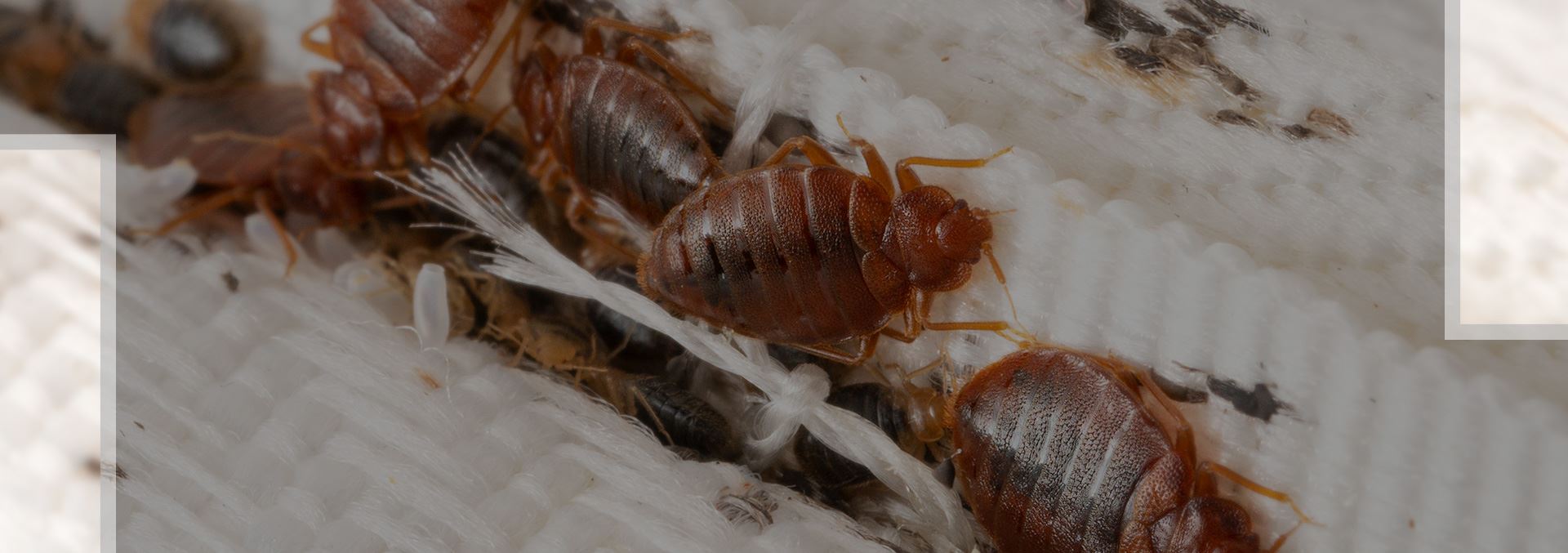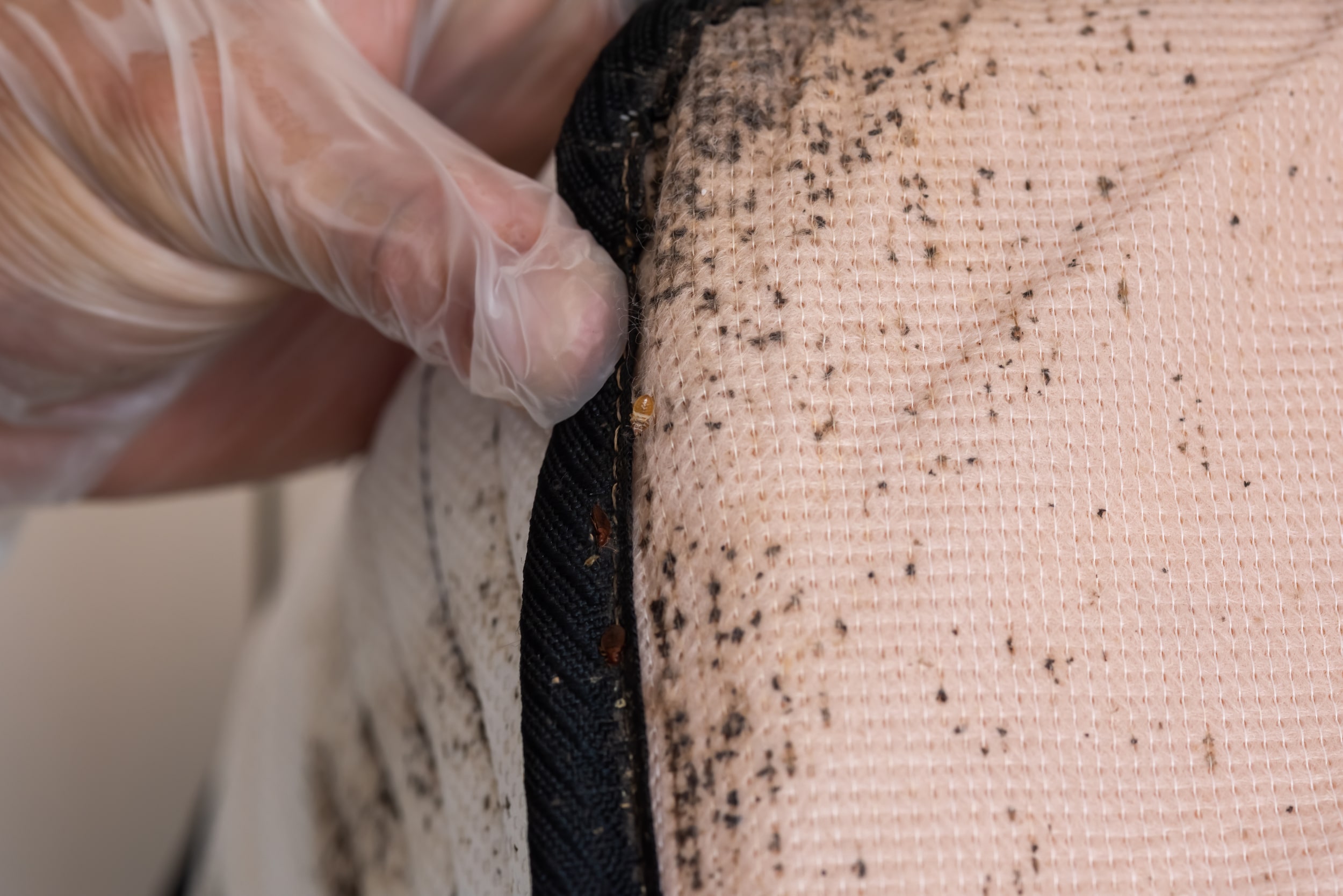Bed Bug Treatments in Florida
Exterminator Services for Clermont, Groveland, Mascotte, Oakland, and Montverde
Florida’s mild winters, abundant sunshine, and near-tropical climate make it a renowned destination for tourists and new residents alike. Yet these same pleasant conditions also cultivate ideal habitats for pests, notably bed bugs. These tiny, nocturnal insects thrive in warm indoor environments, feeding on human blood and multiplying quickly if unchecked. Homes in Clermont, rentals in Groveland, family residences in Mascotte, or short-stay accommodations in Oakland and Montverde alike face bed bug threats. A single overlooked female can lay numerous eggs daily, turning a minor issue into a widespread infestation in just weeks. This service page explores why bed bugs thrive in Florida’s climate, how to spot early warning signs, and why enlisting a professional bed bug exterminator for bed bug treatments is the most dependable route to evict these hidden parasites. By detecting them early and responding aggressively, property owners limit population booms, occupant distress, and the headache of extensive post-infestation cleanup.
Why Bed Bugs Flourish in Florida

- Year-Round Warmth
In cooler regions, extended winters can force bed bugs into dormancy, slowing reproduction for months. Florida’s mild winter rarely persists long enough to curb these insects. Indoors, heating or air conditioning keeps temperatures around the ideal range (65°F to 85°F) for bed bug breeding. Consequently, bed bugs remain active, feeding, and laying eggs without the enforced lull that freezing weather might impose elsewhere. - Population and Tourism Flow
Central Florida, including Clermont, draws people from across the country—tourists, snowbirds, and relocating families. Many rotate through short-term rentals or bring secondhand furniture, which can harbor bed bugs. Luggage, clothing seams, or personal belongings also offer clandestine transport for bed bugs, letting them move from one property to the next. - Minimal Seasonal Slowdowns
Because sub-freezing weather is uncommon, bed bugs seldom experience life cycle pauses. A handful of bugs that slip into a comfy bedroom or living area continue reproducing steadily, possibly for months before residents sense a problem. Only occupant vigilance or professional checks intercept them before they overrun multiple rooms. - Stable Indoor Conditions
Bed bugs target stable, moderate warmth. Heated or air-conditioned environments suit them perfectly. If a property goes unoccupied for a few weeks, bed bugs can persist by feeding occasionally, with no fear of plummeting indoor temperatures that might hamper their growth. Once new occupants arrive, the bugs resume full feeding cycles. - Frequent Short-Term Rentals
In communities with high occupant turnover—like certain neighborhoods in Groveland, Mascotte, or Montverde—bed bugs exploit the constant influx of people. A single infested suitcase introduced by a prior guest can seed a new infestation if the caretaker or occupant does not thoroughly inspect bedding, sofas, or carpets.
Telltale Signs of Bed Bugs
- Itchy, Red Bites
Typically, bed bugs bite exposed skin—arms, legs, neck—leaving small red bumps or welts that itch. Bites may line up in rows or clusters. If family members wake up repeatedly with fresh bites and no sign of mosquitoes or fleas, bed bugs become the prime suspect. - Dark Specks or Rusty Stains on Sheets
After a bed bug feeds, it can be crushed during sleep, creating tiny rust-colored blotches on pillows or sheets. Additionally, small black spots might be bed bug excrement. Checking near corners, under pillows, and mattress edges clarifies whether bed bugs feast at night. - Eggshells and Molted Skins
Bed bugs grow from nymph to adult by shedding exoskeletons. These transparent skins or whitish egg remnants can accumulate around bed frames, baseboards, or upholstered furniture seams. Shine a flashlight into tight crevices to detect these subtle hints. - Sweet or Musty Odor
In large numbers, bed bugs can produce a faint sweet or musty smell due to their pheromones. Though not every infestation reaches that level, combined with droppings or bites, this odor can confirm their presence. - Live Bugs in Seams or Crevices
Adult bed bugs measure around 5–7 millimeters, oval, and brownish-red. Nymphs are smaller and paler. Lifting mattress corners, checking behind headboards, or pulling back sofa cushions can reveal a few scurrying bugs if the colony grows bold.
Consequences of Delaying Bed Bug Treatment
- Fast Population Growth
A single female bed bug lays multiple eggs daily. Under Florida’s warm indoor conditions, eggs hatch within about two weeks, letting each generation intensify the problem. Delaying action fosters an ever-multiplying population that soon extends beyond bedrooms to living rooms, hallways, or adjacent units. - Disrupted Sleep and Stress
Knowing that bugs might feed while occupants rest triggers anxiety, insomnia, or constant worry about the next bite. Over time, daily fatigue and apprehension degrade quality of life, overshadowing everyday routines or social events. - Potential Spread to Neighbors
In multi-family residences or properties with common walls, bed bugs can travel along wiring, plumbing lines, or cracks if only one occupant addresses the issue. Coordinated building-wide checks hamper cross-room or cross-unit invasions.
Damage to Reputation
For short-term rentals, hotels, or even real estate listings, bed bug discoveries undercut occupant trust. Negative reviews or occupant complaints can harm the property’s standing. Rapid detection and discreet professional intervention maintain occupant confidence and preserve brand value.

Why a Professional Bed Bug Exterminator is Indispensable
- Complete Inspection
A trained bed bug exterminator begins by scanning each room thoroughly—examining mattress seams, box springs, upholstered chairs, baseboards, or behind frames on walls. Because bed bugs conceal themselves deeply, only a careful, systematic search ensures none remain undetected. - All Life Stage Coverage
Bed bug eggs, nymphs, and adults each need specific elimination strategies. Professionals employ heat, steam, or specialized insect growth regulators to kill eggs while using targeted insecticides or vacuuming to remove nymphs and adults. This integrated approach prevents re-infestations. - Reduced Chemical Risks
Over-the-counter sprays or foggers, if misused, can push bed bugs deeper behind walls. Experts apply insecticides and growth regulators exactly where bed bugs dwell, minimizing occupant or pet exposure while ensuring bugs cross lethal zones. - Follow-Up Assurance
Because eggs may hatch weeks later, scheduling re-checks or occupant-based monitoring ensures new nymphs face lethal conditions. If occupant bites or sightings persist, additional spot treatments finalize eradication, returning occupant peace of mind.
Methods a Bed Bug Exterminator Might Use
- Inspection and Mapping
Identifying the extent of infestation is key. Specialists track droppings, shells, or live bugs around bedrooms, sofas, or other favored hideouts, shaping a targeted plan. If multiple rooms contain evidence, they ensure each zone receives thorough coverage. - Vacuuming and Steam
Vacuuming lifts visible bugs, shells, and egg clusters from surfaces. Steam kills bugs hidden deeper in fabrics, cushion seams, or carpet edges. Combining these steps reduces the population significantly before residual chemical usage. - Residual Sprays and Dusts
Applying residual insecticides or dust along baseboards, bed frames, or cracks kills bed bugs traveling these routes. Insect growth regulators hamper nymph maturity. Occupants typically wait until sprays dry or dust settles before re-entering treated areas. - Heat Treatments
For large-scale or multi-room infestations, raising indoor temperatures above ~120°F saturates the environment, killing bed bugs hidden in wall voids, electronics, or furniture. Occupants often vacate for the day, returning after the structure cools. Proper heat distribution ensures the entire property faces lethal conditions. - Encasements and Monitors
Sealing mattresses and box springs in bed bug–proof covers cuts off any bugs inside from feeding, dooming them, while preventing new infestations in bedding. Sticky monitors or interceptors under bed legs can reveal post-treatment re-emergence if occupant sightings persist.
Serving Clermont, Groveland, Mascotte, Oakland, and Montverde
Clermont: Known for its rolling hills and recreational lakes. Homes or short-term rentals near these scenic spots sometimes see occupant turnover or secondhand furniture acquisitions—common routes for bed bugs. Prompt occupant checks for bites or black specks hamper expansions into multiple rooms.
Groveland: A growing suburban area interspersed with older and newer residences. Bed bugs can nest behind wallpaper or slip along cracks in baseboards if occupant vigilance wanes. Swift occupant response plus thorough professional solutions ensure small bed bug sightings do not explode into large-scale invasions.
Mascotte: With new housing developments meeting older farmland, Mascotte experiences occupant shifts, possibly carrying bed bugs from prior places. Occupants frequently vacuuming or scanning bedding hamper stealthy bed bug expansions.
Oakland: A quaint community near lake areas. If bed bugs hitch rides in suitcases or secondhand décor, they can hide in rarely accessed corners. Occasional occupant checks—pulling back sheets, shining flashlights behind furniture—uncover early signs and shape minimal-scope treatments.
Montverde: Scenic, with partial-year occupancy from out-of-state owners. Vacant properties left unmonitored might let bed bugs remain hidden, feeding on occasional visitors. Arriving families or renters should verify bedding or corners for droppings or eggs, shutting down potential infestations promptly.

Why Our Bed Bug Treatments Excel
- Florida-Focused Expertise
Mild winters facilitate near-continuous bed bug breeding in southwestern Florida. Our approach merges occupant-based cleaning routines—like laundering and vacuuming—plus targeted chemical or heat solutions that exterminate bed bugs across life stages. We adapt each plan to occupant constraints and infestation levels. - Targeted, Safe Applications
Rather than spraying entire rooms indiscriminately, we concentrate insecticides or steam where bed bugs hide—bed seams, baseboards, behind bed frames, or inside couches. Occupants remain safer from overexposure, and bed bugs face lethal contact in their harborage zones. - Preventative Advice
Beyond removing current infestations, we guide owners on storing luggage, checking secondhand items, or sealing cracks near baseboards. This synergy of occupant diligence and professional coverage blocks re-introductions of bed bugs from outside or repeated expansions within the property. - Follow-Up and Assurance
Because bed bug eggs may hatch after initial coverage, scheduling re-checks ensures no newly emerged nymphs persist. If occupant sightings or bites continue, additional spot treatments finalize extermination, offering occupant relief and stable success.
Next Steps
Waking up to suspicious red bites, spotting black pepper-like specks on sheets, or finding tiny bugs around mattress seams? Contact us to learn more or schedule your service. Our bed bug exterminator solutions in Clermont, Groveland, Mascotte, Oakland, and Montverde eradicate bed bugs across every life stage—eggs, nymphs, adults—before these parasites multiply further, ensuring you reclaim restful nights and occupant peace. Acting swiftly spares you from ongoing itching, repeated laundering, or the dread of new bites.
Maintaining a Bed Bug-Free Environment
With infestations cleared, minor yet consistent measures ward off bed bugs long-term:
- Secondhand Furniture Checks: Thoroughly inspect used couches, bed frames, or other upholstered items for eggs, droppings, or adult bugs prior to bringing them indoors. If uncertain, vacuum or treat them beforehand.
- Frequent Vacuuming: Routine vacuuming of carpets, rugs, or cushions removes stray bugs or eggs. Dispose of the vacuum bag or contents in sealed plastic outdoors to prevent potential re-infiltration.
- Launder and Heat-Dry Bedding: Weekly washing of sheets, pillowcases, or blankets on hot cycles kills bed bugs or eggs resting in seams. Drying on high heat finalizes the kill.
- Encasements: Sealing mattresses or box springs in bed bug–proof covers denies future hiding spots, letting you spot new activity on the encasement surface easily.
- Monitor Luggage Post-Travel: Inspect suitcases for insects, especially if you stayed somewhere with known bed bug incidents. Washing clothes upon returning and vacuuming your bags hamper unwitting bed bug transport.
These occupant-driven habits, paired with timely professional assistance if suspicious signs reoccur, ensure southwestern Florida residences remain bed bug–free. Even though Florida’s climate fosters near-year-round breeding, occupant vigilance plus robust extermination services keep these unwanted parasites from regaining a foothold, restoring stress-free living for families, tenants, or business operators alike.
